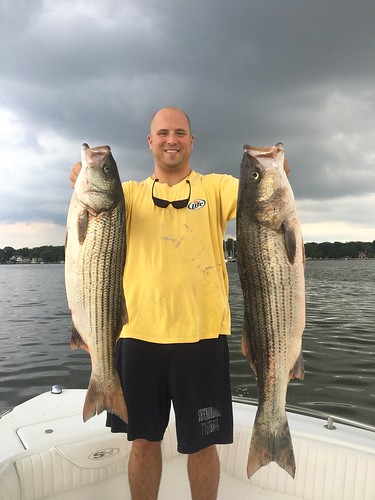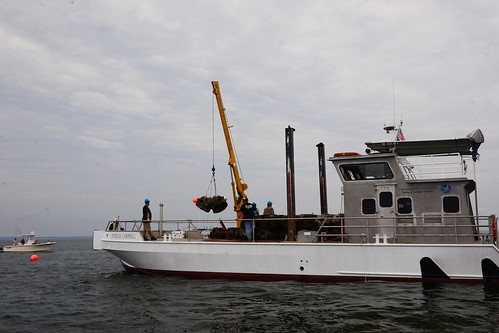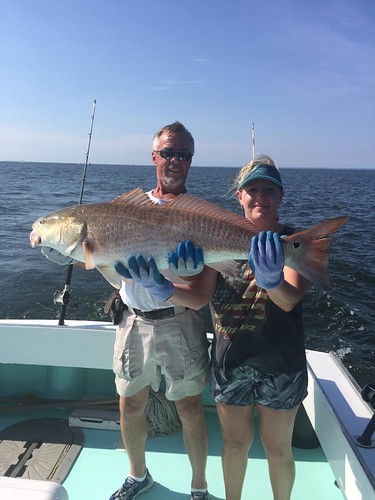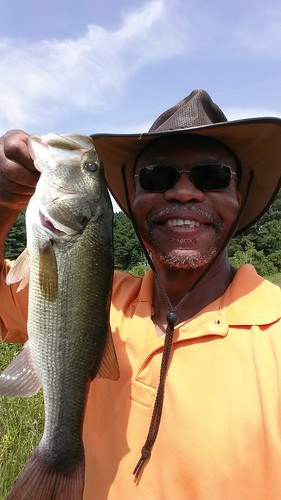Via MD DNR:
By: Keith Lockwood
You may have noticed in the past couple of weeks that the fishing report is becoming shorter and more concise. The Fisheries Service is attempting to make the fishing report more user friendly for mobile phones and easier to get vital fishing information quickly. In the end, we service our readers so let us know what you think about the new format.
Before we get into the fishing reports from around the Bay, here are some thoughts and tips on this summer’s striped bass patterns and water quality in the Bay from Tom Parham, Maryland Department of Natural Resources, Tidal Water Quality Monitoring group.
Where did the Striped Bass go this summer?
- In late summer high surface water temperatures combined with the majority of deeper cooler water experiencing low dissolved oxygen conditions force Striped Bass into a very narrow band of water. This is known as the “Striped Bass Squeeze.” (For example, during June and July, a concentration of striped bass was found in a relatively small area between Sandy Point and Podickory Point at the mouth of the Magothy River).
- Striped Bass can tolerate water temperatures up to about 86F and oxygen levels down to about 3mg/l. However, these conditions are far from optimal.
- Based on the latest Maryland DNR water monitoring data collected July 25-27, there are currently limited areas with suitable temperature and oxygen conditions for Striped Bass.
- Anglers may want to explore the Chesapeake Bay bridge area down to below Eastern Bay at depths between 22 and 28 feet. In addition, consider the mouth of the Choptank River and Tangier Sound in depths down to about 20 feet.
- Note: A restored Chesapeake Bay will provide more areas with suitable dissolved oxygen for fish, crabs and oysters. While Maryland is on track to restore the Bay and we are seeing improvements in our waters in some rivers and streams, we still have more work to do. Please do your part to reduce nutrient pollution to the Bay by keeping your car and boat tuned up and making sure you pump, not dump your boat waste.
- For more information on Chesapeake Bay dissolved oxygen conditions visit dnr.maryland.gov/waters/bay/Pages/Hypoxia-Reports.aspx, and see the following map.

Bay Temperature and Dissolved Oxygen Map, Courtesy of Tom Parham, DNR
At the very top of the bay most fishing has been focused on a mix of white and yellow perch along with channel catfish. The water flows at the Conowingo Dam have been relatively low with only a few afternoon water releases in the past week. The striped bass action really kicks into gear when you get down to the Rock Hall area where Swan Point, the Triple Buoys, Love Point have been a popular places to chum for striped bass. On the western side of the Bay the inside edge of the Craighill Channel from Sandy Point Light to Gibson Island has also been a popular place to anchor up and chum but catches have been falling off as fish look for cooler water more to their liking. Bay water temperatures are now in the high 80s, and mornings coupled with a falling tide usually offer the best action. Pat McLihnney holds up a nice pair of striped bass he caught recently while chumming at the Love Point area.

Photo by Dennis Cain
At the Bay Bridge Piers there are striped bass to be found suspended near the piers and rock piles. Chumming, chunking, live lining white perch or jigging are all effective ways to catch striped bass. The sewer pipe on the northeast side of the bridge has also been getting the attention of boats anchoring up current and chumming or trolling.
Below the Bay Bridge, the 35’ outside edge of Dolly’s Lump and Hacketts Bar have proven to be good places to chum for striped bass and bluefish lately as has over by the Hill off Poplar Island. Live lining white perch and precious spot have also been a great tactic. Breaking fish are becoming a more common site in the middle bay region as a mix of bluefish and striped bass make life tough for bay anchovies and small menhaden. As the month progresses Spanish mackerel will be a more common addition to the melee.
The Tilghman Island Artificial Reef, which is 1.5 miles west of Paw Paw Cove, Tilghman, was recently enhanced with 72 reef balls through a cooperative project between Department of Natural Resources (DNR)/Maryland Artificial Reef Initiative (MARI), Coastal Conservation Association (CCA), Chesapeake Bay Foundation (CBF) and students and teachers from the Science, Technology, Engineering, and Mathematics (STEM) program at Carroll County schools. The DNR/MARI program provided the permits and oversight.

Photo by Joe Evans
Croaker fishing has steadily improved in the middle bay region with the best catches occurring after sunset as the croaker move out of the deep channels to forage on adjacent shoal areas. White perch fishing has been good with the largest perch being caught on bait in some of the deeper waters over good oyster bottom. Smaller white perch are being caught in the shallower areas of the region’s tidal rivers and creeks.
Water temperatures in the middle and lower bay are in the upper 80s now and the shallower water fishery for striped bass is being limited by those high water temperatures. There is an early morning bite before sun rise and one in the late evening but catches of legal-sized fish have been only fair. Bluefish are spread throughout the middle and lower bay regions and range in size from up to 4 lbs or better.
The lower Bay region continues to offer some exciting fishing for cobia this week in the area just below the Target Ship. Chumming has been one of the more popular methods to catch them but they are also being caught by trolling. A variety of surge tube lures (hoses), large spoons and bucktails dressed with sassy shads have been catching cobia and also large red drum. Megan Crabtree gets help from Captain Mike Willey for a quick picture before releasing this beautiful red drum caught while trolling a large Drone spoon.

Photo courtesy of Megan Crabtree
Croaker fishing remains good this week in the lower bay region with the best catches occurring after sunset on 15’ to 20’ shoal areas adjacent to deep channels. Sea trout, speckled trout, small bluefish and white perch help round out the bottom fishing mix. The largest white perch are being caught in 20’ or more of water over live oyster bottom on bloodworms and peeler crab baits.
Recreational crabbing continues to be good in all regions of the bay with the best catches of large crabs coming from deeper waters in the lower regions of the tidal rivers. There is a big shed going on so crabbers will see a lot of light crabs. The crabs tend to be smaller the farther up the tidal rivers one crabs and some of the best crabbing in Maryland waters is occurring in northern Dorchester County.
Recreational crabbing in the Wye and Miles Rivers has been reported to be rather lack luster this week.
Despite what seems like Kamikaze boating traffic on Deep Creek Lake there is good fishing to be found in the early morning hours on the lake. The best smallmouth bass fishing is occurring in about 10’ to 15’ depths on deep diving crankbaits. There is also a mix of large yellow perch, chain pickerel and the occasional northern pike being caught at these depths over rocky bottom and grass. The best largemouth bass fishing has been under the floating docks around the lake by flipping soft plastics under the docks.
The upper Potomac River received some much needed influx of runoff to raise the water levels and lower water temperatures a bit and creating better fishing for smallmouth bass. Most of the bass being caught are in the 14” size range but offer a lot of fun fishing. Tubes, soft jerkbaits and small crankbaits are good choices for baits this week.
The cool runoff from recent rain storms has cooled water temperatures a bit and although some areas are stained, largemouth bass fishing took an upswing this week. It is still an early morning and late evening fishing situation when the bass are more active. Targeting grass, sunken wood and creek mouths are a good tactic with soft plastics and topwater lures and small crankbaits. Russ Anderson is certainly happy with this largemouth bass.

Photo courtesy of Russell Anderson
In the back bay areas of Ocean City and Assateague, flounder fishing has been good in the channel areas. Many of the largest flounder are being caught on Gulp Mullet baits but a good share of the flounder are also being caught on minnows and squid. At the inlet and Route 50 Bridge area flounder are being caught but the most exciting news is the bluefish that tend to swarm through the inlet at times.
Casting Got-Cha plugs, spoons and jigs has been the favored tactic to catch a mess of bluefish and the occasional striped bass over 28”. Sheepshead are becoming more common at the South Jetty and even a few gray trigger fish have been caught by those using sand fleas for bait. In the surf kingfish are the big attraction for those using bloodworms or squid and bluefish are being caught on finger mullet. Inshore sharks are being caught and released on menhaden cut baits and stout tackle.
Offshore, the tuna chunk bite at Massey’s Canyon has dropped off and very few yellowfin tuna are being caught; water temperatures there have risen to 81° in the area. Sites along the 30 fathom line such as the Hot Dog, Jackspot or the Sausages are worth checking. Boats have been experiencing good sea bass fishing at the wreck and reef sites with a healthy addition of flounder. Farther offshore boats and crews are trolling the canyons and catching a mix of white and blue marlin, bigeye tuna, yellowfin tuna and dolphin.
No comments:
Post a Comment